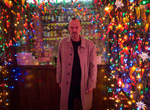Michael Keaton The Founder
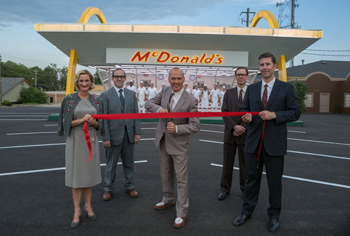
Michael Keaton The Founder
Cast: Michael Keaton, Laura Dern, Nick Offerman, Linda Cardellini, Patrick Wilson
Director: John Lee Hancock
Genre: Biography, Drama
Rated: M
Running Time: 115 minutes
Synopsis: 'The Founder" is a drama that tells the true story of how Ray Kroc, a salesman from Illinois, met Mac and Dick McDonald, who were running a burger operation in 1950s Southern California. Impressed by the brothers' speedy system of making the food at their San Bernardino hamburger stand and the crowds of patrons it attracted, Kroc immediately saw franchise potential and maneuvered himself into a position to be able to pull the company from the brothers and create a billion-dollar empire. And thus McDonald's was born.
Michael Keaton stars as the maverick American entrepreneur Ray Kroc, who transformed McDonald's from a San Bernardino hamburger stand into a global empire now with over 35,000 locations around the world.
Nick Offerman and John Carroll Lynch portray Dick and Mac McDonald, the innovative brothers whose assembly line system brought industrial efficiency to the preparation of their limited menu of burgers, fries, shakes and sodas during a dynamic period in postwar America when people were time-strapped and clamoring for speed.
Also starring are Laura Dern as Ray Kroc's first wife, Ethel, and Linda Cardellini as Joan Smith, the wife of one of Ray's early franchisees who would later marry the entrepreneur. Joining them are Patrick Wilson as Minnesota restaurant owner and McDonald's franchisee Rollie Smith, and B.J. Novak as Harry Sonneborn, the financial whiz whose franchising innovations led to Kroc being able to wrest control of McDonald's from the founding brothers.
The Founder
Release Date: November 24th, 2016
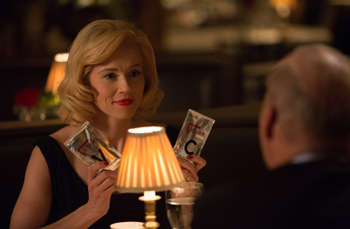 About The Production
About The Production
The Story Of The Founder
The year is 1954. Marilyn Monroe has just married Joe DiMaggio; Elvis Presley records 'That's All Right" and 'Blue Moon of Kentucky" for Sun Studio in Memphis; film producer Walt Disney is in the final stages of construction on his namesake theme park in Anaheim, California; and young homebuyers are flocking to the planned community of Levittown. While the country was undergoing a postwar boom, in Illinois, 52-year-old businessman Ray Kroc is trying to make a living as a traveling salesman for Prince Castle Sales, whose main product is the five-spindle Multimixer used for making milkshakes at the popular drive-in restaurants that Americans are enjoying during this booming postwar period.
While Ray struggles to make sales on his daily travels across the Midwest, his dutiful longtime wife Ethel holds down the fort back at their home near Chicago. While she has tried to provide Ray with support over the years, the tempo of his restless business life and pie in the sky ventures has her patience wearing thin.
When Ray hears that one particular drive-in restaurant way out west in San Bernardino, California has ordered six of his Multimixers, it immediately captures his attention. What restaurant could possibly need to make 30 milkshakes at once? So he sets out for California to meet with Dick and Mac McDonald, the purveyors of their eponymous popular hamburger stand, McDonald's. When he sees their remarkable operation, lights go off in Ray's head. He is certain that the brothers' radical concept – assembly-line style food preparation and pared-down but high-quality menu - has the potential to explode across the country, dotting every main street from coast to coast like a courthouse or a church.
Prior to their career as restaurateurs, the McDonald brothers worked in Hollywood driving trucks for Columbia Pictures during the Depression. But when they discovered the potential for profits by being their own boss in the food service industry, they left and opened a hot dog stand in Arcadia. That spawned their first McDonald's, which they set up in nearby San Bernardino, where their 27-item menu included every food imaginable.
Trying to save money through efficiency, the brothers created a revolutionary approach they called the Speedee System. The typical drive-in menu at the time was a sprawling affair, so the McDonald brothers pared it down into just the few items that most people were buying: hamburgers, fries, and soft drinks. And this would be at a walk-up restaurant, not a drive-in. And finally, in their custom streamlined kitchen, the food preparation became a highly synchronized dance of speed and efficiency.
At first the McDonald brothers hire Ray to be their franchising agent. Upon seeing Dick McDonald's design of the unique golden arches exterior, Kroc insisted that every location should feature the iconic flourish, which stood out to passersby like a glowing halo.
The golden arches were like a Pop Art beacon and instantly became a symbol as recognisable and ubiquitous as a bottle of Coca-Cola or can of Campbell's Soup.
Back in Chicago, Ray begins recruiting scores of franchisees to open their very own McDonald's. In short time, Ray Kroc had opened 13 restaurants in and around Chicago and the Midwest with grand plans for expansion on both coasts and across the country. After years of toil, things are finally going well for the middle-aged entrepreneur. He meets a young and attractive kindred spirit in Joan Smith - the wife of one of his new franchisees – it soon spells trouble at home. And although the franchising operations are successful, Ray is under personal financial pressure because of his small cut. He's also impatient over the slow rate of expansion, and frustrated by the stringent restrictions the McDonald brothers have placed on the design and basic operation of the restaurants. Ray has a vision of global domination for McDonald's and does not want the two small-town hamburger guys slowing him down.
That's when Ray meets Harry Sonneborn, a financial whiz who offers him cogent advice: if Ray would think of McDonald's as a real estate business rather than just a burger business, he may be able to sever his ties with the McDonald brothers and profit beyond his wildest dreams. Harry's idea is simple: Ray would buy the land for future McDonald's sites and then franchisees would lease it from him. That cut out the McDonald brothers since their rights only extended inside the walls of the restaurants and gave Ray a steady revenue stream.
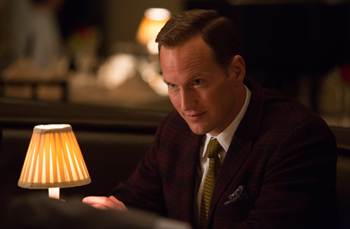 Ray puts Harry's clever and successful idea into action earning the bulk of the profits and leaving the McDonald brothers behind. In 1961 Ray buys out the brothers' stake in the McDonald's and becomes its owner, president and CEO, and goes on to build the fastfood empire that makes him a legend in his own time.
Ray puts Harry's clever and successful idea into action earning the bulk of the profits and leaving the McDonald brothers behind. In 1961 Ray buys out the brothers' stake in the McDonald's and becomes its owner, president and CEO, and goes on to build the fastfood empire that makes him a legend in his own time. For producer Don Handfield, 'The Founder" began with a song. Back in 2004, when he was casually listening to 'Boom, Like That," a single from the just-released solo album from Dire Strait's singer-songwriter Mark Knopfler, the producer, who is partners with actor/producer Jeremy Renner in their Los Angeles-based production company, The Combine, was instantly intrigued. The lyrics of the song – Knopfler's reflections from reading Ray Kroc's autobiography - detail how the milkshake mixer salesman from Illinois first visited the McDonald brothers in San Bernardino and pitched them the idea of franchising their restaurant. Curious about the man at the center of the song, Don Handfield remembers thinking, Who was this guy? What is this about? Like everyone, Don Handfield was familiar with the ubiquitous fast-food restaurant, but he wanted to know more about its story of how it all began.
Don Handfield says he read every book and article he could find on Ray Kroc. 'Like today's Silicon Valley startups, it was such a fascinating story about two brothers who created something and then the business guy comes in and takes it to the next level. And often the split between the founders and the business guy is a violent one. This story had all the echoes and machinations of that."
As Handfield continued doing research into Ray Kroc and the McDonald brothers, the characters and theme of the kind of movie Handfield wanted to make began to gestate. According to Don Handfield, there are two forms of capitalism represented by Ray Kroc and the McDonald brothers. 'The McDonald brothers were very much like sustainable capitalism, like, we're going to make great product. We're going to leave a minimal footprint. We're going to take care of our employees - I guess you would call it sustainable capitalism. And on the flip side you have Ray Kroc, who, if you could drop him in the jungle he'd cut down every tree and come out with a suitcase full of cash."
At the heart of Don Handfield's interest was the story of two idealist entrepreneurs facing off against a ruthless entrepreneur would stop at nothing to succeed. Still, Don Handfield admits, he does admire Ray Kroc, a man who at the age of 52 still had the drive and stamina and confidence to do whatever it took to start an empire.
Don Handfield says he chased the story for five years before serendipity arrived in the form of a random Internet search. While doing a Google search late one night, he came across a small article with an interview with Dick McDonald that mentioned he owned a small motel in Massachusetts. He called the current owner of the hotel and said he was a producer and wanted to make a movie about the McDonald family, and the owner passed that message along to the McDonald's family. That lead ultimately led him to Jason French, the grandson of Dick McDonald who said he'd been waiting 50 years for someone to call and tell this story. Dick and his brother Mac had passed away several years earlier so Jason French was informally appointed by the family to handle discussions with the Hollywood producer. For such an iconic part of American history, Don Handfield was surprised to learn that in all that time, no reporter, journalist, or movie producer, had ever reached out to them.
Excited to have the true story of the founding of McDonald's told from their point of view, French and the members of his family shared archival materials and McDonald's memorabilia with Don Handfield, including letters between the McDonald brothers and Ray Kroc, archival photographs, various designs and mock-ups, as well as Dictaphone recordings of their conversations. 'This was all stuff that was valuable when we began to create the story," Don Handfield relates. 'The story was never going to be a movie about fast food. To me the story was always about capitalism."
'This is unbelievable for our family to have this story being told and bringing to light how everything came about and how McDonald's was formed," says Jason French. Jason French says his grandfather and great uncle were great innovators, creating processes that would be put into effect not only in his own restaurants, but that created the standards for fast food restaurants everywhere. 'My grandfather was a man that had so many thoughts, dreams and came up with so many things before their time, it's unbelievable. He was a guy who thought how can we make it better? How can we do it faster? And how can we make things move more effectively?"
A decade after Handfield first heard Mark Knopfler sing the lyrics to the fateful tune, I'm going to San Bernardino ring-a-ding-ding / Milkshake mixers that's my thing now / These guys bought a heap 'o my stuff / And I gotta see a good thing shooting up now, the producer had finally secured film rights from the McDonald's family. With a movie concept in place, Handfield and his producing partner Jeremy Renner brought the project to veteran producer Aaron Ryder, the co-president of production at FilmNation Entertainment, who immediately loved the idea. 'It's exactly the type of film that we do," Aaron Ryder says about the New York-based film production and distribution company.
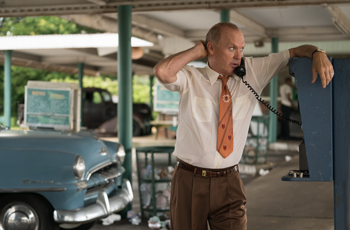 'It's a movie about America and capitalism. It's about the pursuit and the erosion of integrity, and determination of succeeding. It's a story that shows the American dream: that you can succeed despite the odds by just sheer force of will."
'It's a movie about America and capitalism. It's about the pursuit and the erosion of integrity, and determination of succeeding. It's a story that shows the American dream: that you can succeed despite the odds by just sheer force of will." The project quickly began to fall into place. Before bringing in a director to visualise the film's artistic and dramatic aspects, the producers felt they needed to have the right script.
In choosing a screenwriter who could take a legendary story and transform it into a character piece, the producers met with several writers until they found one whose vision for the project resonated with them. In 2013, Don Handfield contacted screenwriter Robert Siegel, who had just written 'The Wrestler," and whose sensibility he thought might be a perfect match to trace the rise of Ray Kroc from a hustling salesman into the chairman of a global fast food empire. 'We talked with a bunch of writers about how they would go about this," Don Handfield recalls. 'And Rob Siegel's take was in making it the McDonald brothers' story but from the point of view of Ray Kroc, and I think that was a really original and powerful way to approach it."
'I like to write kind of big American stories," proclaims the screenwriter who is also known for writing and directing the Spirit Award nominated comedy-drama 'Big Fan" with Patton Oswalt. 'And the genesis of McDonald's touched on all these big American themes: the car culture, the -50s, the rise of the suburbs, and fast food, and capitalism, and greed. There's such an epicness to the story. It's such a big untold story. It was kind of the birth of fast food which has had reverberation on how we eat, and where we eat, and who we eat with."
Rob Siegel instantly responded to the character and saw incredible potential. He says, 'Ray Kroc is such a big, complicated, larger than life, polarising figure who does whatever it takes to get his way." Armed with hundreds of pages of research materials about Ray Kroc and McDonald's, the writer also explored the general landscape of America in the 1950s. 'Post World War Two the country was just exploding," Rob Siegel says. 'It was just rock and roll, car culture, youth culture, and drive-ins. And here you have this man who is completely out of time. It's an Elvis Presley world and Ray Kroc's a Bing Crosby man." However much a fish out of water he was in that era, Rob Siegel notes that Ray Kroc would go on to be one of the major drivers of -50s culture, and on through the -60s, -70s and beyond.
For Rob Siegel, the origin story of Ray Kroc and McDonald's reminded him of another corporate titan, Mark Zuckerberg, and the problematic founding of the social media site Facebook as depicted in David Fincher's -The Social Network." 'I tend to gravitate toward dark," Rob Siegel expresses. 'I like dark, complicated, messed up characters. And when Don [Handfield] and I started talking, we really saw things in a similar way, about building this portrait of this larger than life guy who changed America, and changed the world, and left a lot of human wreckage in his wake." In crafting the screenplay Rob Siegel also sought inspiration from films such as 'There Will Be Blood," 'Citizen Kane," and 'Tucker: The Man and His Dream," and books like Robert A. Caro's book, The Power Broker: Robert Moses and the Fall of New York, all of which detail maverick titans of industry. Ray Kroc lived a long life filled with many chapters, so creating the structure of the film was a challenge. Rob Siegel explains, 'There was no need to focus on the early years that much, so the starting point for the movie is this failed salesman who hadn't achieved any success until he was already pretty much at retirement age. At that time, he was in his mid-50s when he came upon the McDonald brothers."
Combining a strong character study and themes of America in the 20th century, Rob Siegel turned in his first draft of the script in eight weeks. For Rob Siegel, the defining moment in the story that set him in motion is when Ray Kroc first lays eyes on McDonald's. 'That's his burning bush moment," he muses. 'He's this guy who's just been literally wandering in the desert, wandering the back roads of America selling these Multimixers for decades with no pot of gold. There's no reason to think this guy is headed for anything special. He's at a point in his life when he should be retiring. So when he sees this booming restaurant in the middle of this dusty, desert town of San Bernardino, he feels like, this is my purpose, this is my calling."
Ray Kroc had always wanted to be a success, and when he meets the McDonald brothers he realises he has the opportunity to do something great and prove all of his naysayers wrong. 'It's redemption, I think, for the lonely, miserable life on the road as a traveling salesman," Rob Siegel contemplates. He adds that one of the admirable things about the visionary entrepreneur is that whenever he was beaten down, he would just get back up.
'Even in the face of all this evidence that he was unremarkable, and absolutely not destined for anything special, he believed there must be a purposes to all of this. A reason why he was grinding it out. That's the name of his biography, -Grinding it Out,' and that's what he was. He was a grinder and he had this drive. He always felt that there was some sort of destiny, and always had faith that this was all for something."
The film's title, 'The Founder," refers to the oft-cited description of Ray Kroc as the founder of McDonald's, but for the filmmakers it was infused with irony. 'Ray wasn't the founder of McDonald's," Don Handfield asserts. 'He didn't create the Speedee System. He didn't create the restaurant. But without Ray Kroc, McDonald's would not have been the worldwide global brand it is today. Screenwriter Robert Siegel echoes that sentiment. 'Ray certainly admires the McDonald brothers," the screenwriter allows.
'They've done something he was never able to do, which is come up with an original idea. They also thought big and had ambition. But Ray thought huge! He wanted 2,000, 3,000 franchises, which at the time sounded insane. So he was not the founder. But he called himself the founder. As soon as he acquired the company, he went about slowly rewriting the history of the company, and kind of wrote them out of their own story."
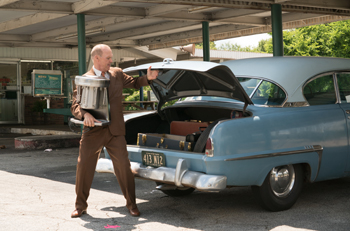 With a script they felt was ready to be fully realised on screen, the producers partnered with award-winning writer, director, and producer John Lee Hancock, to direct the film. Aaron Ryder says that in addition to being a seasoned writer and director, Hancock is one of Hollywood's most amiable guys. 'He's someone who knows exactly what he wants to do, and who surrounds himself with collaborators with whom he's worked for the last ten or fifteen years," Aaron Ryder says. The multi-hyphenate artist has directed a long string of critically acclaimed and successful films such as the sports dramas 'The Rookie" and 'The Blind Side," and most recently the 1960s period drama, 'Saving Mr. Banks," starring Tom Hanks as filmmaker-businessman, Walt Disney. Don Handfield says 'I thought he was perfect for it because in some ways, he's like the Frank Capra or Norman Rockwell of our time. He's this guy who tells these very American stories in a very timeless way. What better guy to tell this big origin story that takes place in America than John Lee Hancock?"
With a script they felt was ready to be fully realised on screen, the producers partnered with award-winning writer, director, and producer John Lee Hancock, to direct the film. Aaron Ryder says that in addition to being a seasoned writer and director, Hancock is one of Hollywood's most amiable guys. 'He's someone who knows exactly what he wants to do, and who surrounds himself with collaborators with whom he's worked for the last ten or fifteen years," Aaron Ryder says. The multi-hyphenate artist has directed a long string of critically acclaimed and successful films such as the sports dramas 'The Rookie" and 'The Blind Side," and most recently the 1960s period drama, 'Saving Mr. Banks," starring Tom Hanks as filmmaker-businessman, Walt Disney. Don Handfield says 'I thought he was perfect for it because in some ways, he's like the Frank Capra or Norman Rockwell of our time. He's this guy who tells these very American stories in a very timeless way. What better guy to tell this big origin story that takes place in America than John Lee Hancock?" In his last film, 'Saving Mr. Banks," John Lee Hancock created 1906 Australia and 1961 Los Angeles, so he was familiar with the notion of creating a believable world in an earlier time period. With 'The Founder," that period is 1954-1961, a time in America when much of the country was quickly catching on to the idea of mass production. In this optimistic post war period of Elvis Presley, a new modern suburbia of interstate highways, roadside motels, and fast food was also first coming into existence. 'It's always a lot of fun to do films set in the past," John Lee Hancock says. 'Because of the cars, because of the clothing, and also looking for anachronisms. It's definitely easier to do a contemporary movie, but there's something satisfying about being able to time travel." Hoping to provide audiences with great characters and an entertaining experience, the filmmakers behind 'The Founder" also believe that the story of Ray Kroc and the McDonald brothers will serve to humanise the ubiquitous global fast food chain. 'I think when people learn about the story behind McDonald's, that it will give the company a human feel that I think they've lost in the past five decades," producer Don Handfield observes. 'The McDonald's Corporation might be unsettled by the prospect of a wartsand- all movie about Ray Kroc, but I think they'll pleased when they see the movie. Every time I pass by a McDonald's now I don't see this massive corporation that makes fast food. I see two brothers who loved each other and who wanted to make fast food for families that was affordable and good." Even though 'The Founder" presents the candid origin story of the fast food chain, producer Aaron Ryder believes that McDonald's should be very excited about 'The Founder." 'Every time I read the script, I wanted to go out and eat a McDonald's hamburger! Every person in the United States has some sort of relationship or familiarity with McDonald's. And if you're able to tap into that nostalgic feeling and get people to go back to that because they want to eat a McDonald's hamburger, that's going to help them."
The goal of the movie, Don Handfield says, is not to vilify Ray Kroc or glorify the McDonald brothers. 'I think half the people will come out and go, -Ray Kroc's an American hero,' and half the people will come out and go, -Man, the McDonald brothers sure were American heroes," he speculates. 'And I think that's good. I think Ray Kroc in some ways is just driven by desperation and fear. He didn't want to be a failure. He wanted to be successful by any means necessary to get there. And I think we've kind of adopted that as our national credo - it's all about being successful at any cost."
One Oscar® Nominee, Two Talented Character Actors, A Gifted Ensemble… Special Sauce, Lettuce, Cheese, Pickles, Onions On A Sesame Seed Bun. Casting Begins
As producer and FilmNation executive Aaron Ryder recalls, he, John Lee Hancock and Ryder's FilmNation colleague, executive producer Glen Basner, were out in a bar one night – 'where all great decisions are made" – and were talking about the casting. 'I said to John Lee Hancock, you should go home tonight and write down five names on a piece of paper of who you think should be Ray Kroc and put it away for a few days and don't think about it," he remembers. 'Then take that piece of paper out and circle two names. So he did just that and the first name he circled was Michael Keaton. I don't even remember who the second name was because it was so perfect for Michael Keaton." Michael Keaton was coming off of 'Birdman" and had just won the Golden Globe award for Best Actor. Around the same time producer Don Handfield also noticed a black and white photo of Keaton on the cover of Entertainment Weekly magazine and immediately thought, 'That's Ray Kroc!"
He recalls, 'He looked exactly like him. Michael Keaton is such a phenomenal actor and has done such a variety of roles that I knew it would be a dream come true to have him star in the film. He's the kind of actor that embodies the prototypical American dream." Michael Keaton plays Ray Kroc, the man who took a concept originated by the McDonald brothers and successfully transformed it into a national chain. Following an acclaimed career punctuated with iconic roles in classic films such as 'Batman" and 'Beetlejuice," Keaton earned an Academy Award® nomination for his starring role in the Oscar® nominated film, 'Birdman."
Once he took on the character of Ray Kroc, Michael Keaton says everything just clicked into place. 'The first time I heard about this project and started reading the script, my first thought was, why has no one told this story before?" the actor reflects. 'This is a classic, capitalist, American story. And everyone has a connection to McDonald's – no matter what you may feel about them as an adult. It's a childhood connection. It's not just a hamburger or food. McDonald's was the biggest shift in popular culture and fast food that there will ever be. It wasn't just about a hamburger. It's where America was at the time and how it changed everything."
'The Founder" marks the first collaboration between Michael Keaton and director John Lee Hancock, but it was clear early on that the men had developed a close working relationship in the creation and portrayal of the film's central character. John Lee Hancock says the film literally rests on John Lee Hancock's portray of Ray Kroc. 'This movie is carried on Michael Keaton's back," John Lee Hancock asserts. 'He's in almost every scene and it's his journey through all this." That journey would take Ray Kroc from a 52-year-old traveling salesman to the boardroom of one of America's fastest-rising companies. 'I knew he'd be great," he continues, 'but he was even better than I thought. He's just so gifted, so talented, so easy to work with and willing to try lots of different things. He doesn't play it safe and will go for anything."
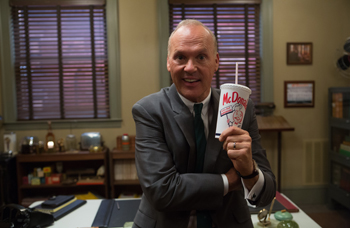 Screenwriter Robert Siegel echoes the sentiment about Keaton, a Pittsburgh native who Siegel thinks is perfect to play a Midwesterner who comes across as a real fish out of water when he gets to sunny California. 'He's so charming, but when he needs to he can also be oily," he says. 'He can talk fast. He's done a lot of roles where he has that quality of desperate salesmanship. He could have been in -Glengarry Glen Ross,' or played Willy Loman. He can be tragic and then charming and charismatic at the same time."
Screenwriter Robert Siegel echoes the sentiment about Keaton, a Pittsburgh native who Siegel thinks is perfect to play a Midwesterner who comes across as a real fish out of water when he gets to sunny California. 'He's so charming, but when he needs to he can also be oily," he says. 'He can talk fast. He's done a lot of roles where he has that quality of desperate salesmanship. He could have been in -Glengarry Glen Ross,' or played Willy Loman. He can be tragic and then charming and charismatic at the same time." For the roles of Dick & Mac McDonald, Ray Kroc's partners and eventual adversaries, producer Aaron Ryder says it took a long time to figure out whom to cast in the roles. 'The McDonald brothers are something I'm very proud about in how we cast," Aaron Ryder states. 'It's always difficult when you're casting brothers, because if you cast one, you had better find someone else that is able to match him physically. And that was a challenge. And John [Lee Hancock] always had this idea that the McDonald brothers would be these very American, round shouldered guys." They first cast Nick Offerman who was on their short list and available during the summer hiatus of his NBC series 'Parks and Recreation," followed soon after by character actor John Carroll Lynch.
'They looked good together," Aaron Ryder says. 'We put their photos next to the real McDonald brothers and thought they were a good pairing, in addition, of course, to being funny and good actors as well."
Actor and humorist Nick Offerman plays Richard 'Dick" McDonald, the younger of the McDonald brothers who founded McDonald's in San Bernardino, and known as the more creative, design-savvy member of the duo. In addition to many of his other innovations and inspired by the vocabulary of postwar architecture, Dick originally designed the chain's legendary golden arches in an effort to make their restaurant stand out for passersby, and in doing so created one of the most iconic restaurant designs in restaurant history.
For 'The Founder," the comedic actor, currently seen as a star of the hit NBC ensemble comedy series 'Parks and Recreation," plays one of his first dramatic roles. According to producer Aaron Ryder, 'He's done smaller movie roles and some independent films, but you've never seen him play serious before, in this sort of a texture of a role." On his character of Dick McDonald, Nick Offerman – who proposes that 'the McDonald brothers are the Henry Ford of fast food" – says, 'Mac is really gregarious and the people-person," he says. 'I think if we were selling cars, Mac would be the one putting people in their dream cars, and Dick would be crunching numbers, spinning tires, using a timing light and fine-tuning the automobiles." The actor/humorist is also a woodworker in his spare time, running his 'kick-ass wood shop," Offerman Woodshop, in the trendy Atwater Village neighborhood on the east side of Los Angeles. 'So as a tool guy and a shop guy, I'm thrilled to play the sort of nuts and bolts – or the brains - behind the outfit." For the 1950s role of Dick McDonald and stepping into what he refers to as a 'Norman Rockwell painting," Offerman had to shed his iconic 'Parks and Recreation" mustache. He adds, 'Just this haircut and wearing glasses and a suit to work at a restaurant really puts me into the business-like frame of mind that I think Dick McDonald maintained.
Nick Offerman notes that he's always been fascinated in the truth and history behind fast food, having devoured Eric Schlosser's book, Fast Food Nation and books by author and foodactivist Michael Pollan, and thus felt privileged to play a character that represents one side of the McDonald's story. Nick Offerman asserts, 'Ray Kroc puts it very well in the film when he says to the brothers, -You're going to have many imitators try and do this,' but it's the name McDonald's and the feeling of the name and the idea of this all-American hamburger stand - that's what people are paying for." Nick Offerman contends that when McDonald's first opened their San Bernardino hamburger stand in the 1940s, President Franklin D. Roosevelt's New Deal legislation had just come into play and Americans felt like they deserved what they wanted – and fast. 'We should get our meals and our cars and our jobs and our goods in a much faster, more automated way," Nick Offerman says. 'And Kroc saw that. He smelled it coming and capitalised on it."
Prolific American character actor John Carroll Lynch, who got his first big break as Norm Gunderson in the Coen brothers' film 'Fargo" and has appeared in several TV series, plays Dick's older brother Maurice 'Mac" McDonald. As John Carroll Lynch explains, 'It seems that Mac was the people person. He really liked people – I would bet he was the guy who hired people. He was the person who made sure the payroll was done and all that. And Dick was the idea man. They complemented each other perfectly that way. And that's portrayed in the film, that they were very much different people, but perfectly complemented to create the company." The McDonald brothers lived together most of their lives and were very close. They were business partners and friends. Their relationship was centered around the business.
At their first San Bernardino dinner meeting with Ray Kroc, Mac McDonald regales their future franchising partner with the history of how he and Dick got started. The scene, which was filmed in an Italian restaurant in Atlanta on John Carroll's first day on the film, required John Carroll Lynch to perform a five page monologue. 'There's a key to this movie," John Carroll Lynch offers, 'and it's speed. Speed is the name of the game for the both the franchise and the film. The film needs to move. And there's this long monologue in the movie where you see the growth of the McDonald brothers' concept of McDonald's from when they started becoming restaurateurs, to the time they develop this Speedee System. It's kind of McDonald's History 101, if you will." John Carroll Lynch says that as a film actor one rarely gets the opportunity to have a five page monologue, but having a theatre history certainly helped, although, he adds, 'you never get a five page monologue in theatre either." Although Dick & Mac McDonald are the true founders of their namesake restaurant, it is Ray Kroc who is most recognised in history as its founder, something John Carroll Lynch attributes to Kroc's quest for total dominance in their business dealings. John Carroll Lynch says that Dick and Mac had no idea what they were getting into when they got into business with Ray Kroc.
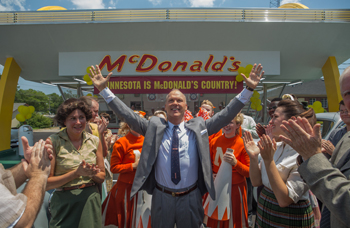 'They didn't quite realise how cutthroat he was," John Carroll Lynch says, noting that the brothers view of capitalism was radically different that the man who would later run them out of business. 'The McDonald brothers' viewpoint of capitalism is really about excellence and efficiency, and I think that's true of Ray Kroc too. But Ray Kroc adds the word -dominance' to that equation. So it becomes excellence, efficiency and dominance."
'They didn't quite realise how cutthroat he was," John Carroll Lynch says, noting that the brothers view of capitalism was radically different that the man who would later run them out of business. 'The McDonald brothers' viewpoint of capitalism is really about excellence and efficiency, and I think that's true of Ray Kroc too. But Ray Kroc adds the word -dominance' to that equation. So it becomes excellence, efficiency and dominance." According to producer Don Handfield, Nick Offerman and John Carroll Lynch had an instant rapport together. 'You really believe they're brothers, that they have this history, and they have this love, and they have this great way of communication without talking that makes you feel like these guys really did grow up together," he says.
Two-time Academy Award® nominee Laura Dern plays Ethel Kroc, Ray Krok's longtime wife of 39 years, who suffers through his various business schemes and feels neglected while Ray spends most of his time on the road. Ethel has stuck with Ray through all of his sales ventures, whether selling paper cups or the ill-fated collapsible table-and-bench combination called the Fold-a-Nook. Now, in her 50s, Ethel longs to just relax at the country club with their friends or travel, and not sit at home while her husband mortgages their home for his latest idea. For the role of Ethel, producer Don Handfield feels that Dern came in with a brilliant understanding of the character and how Ray and Ethel's marriage had to be based on humanity. On the human connection between these two people, Don Handfield says, 'Laura has such a keen understanding of playing a character in a way that, even if there were things on the page that may not be likable, she can humanise them and make you understand," he says.
Dern, who first got to know director John Lee Hancock when he was the writer of Clint Eastwood's 'A Perfect World," that she co-starred in with Eastwood and Kevin Costner, says she was intrigued with playing a woman married to not only an obsessive, driven, entrepreneur, but also someone who has a manic level of drive in his hunger to succeed.
'How do you do that?" she asks. 'How does it last? How does it fall apart? All those questions hopefully keep the human and moral center to the business side of the story." Dern says she was lucky in that being an actor for so long she was quite familiar with the film's time period having played several characters in and around that era. Dern also took inspiration from her own family; her mother was raised by her father, a traveling salesman who had a drive similar to Ray Kroc's, but which also caused loneliness for her grandmother.
Dern says that when we first meet Ray and Ethel they are at a critical moment in their marriage. In his autobiography, Kroc refers to his marriage as 'a veritable Wagnerian opera of strife." 'Ray has not been the success story he wants to be," Dern reflects, 'and although Ethel tells him that she's satisfied and can't this be enough, he's terrified that that's going to drag him down. Because satisfaction means not being part of the win; that he'll get lackadaisical with that energy." She adds that at that point in Ray's life, he needed to find someone with equal drive. 'When you enter a man's life when he's starting the race and he already knows what the outcome has to look like and he doesn't succeed in the years he is with her, it's going to be her fault. But if that same woman had met him 15 years later, they might have had an amazing marriage."
Joan Smith, the striking blonde piano player in her husband Rollie's Minnesota steakhouse who makes an immediate impact on Ray Kroc, is played by Linda Cardellini.
For the part, the filmmakers were looking for a blonde, Midwest Doris Day type. However, impressed by her work on 'Mad Men" and the Netflix series 'Bloodline," the normally dark-haired actress was chosen. 'Linda is a bit of a chameleon, so she fell right into it," Aaron Ryder says. 'She came in for an audition and started to sing this song her character sings the movie, and there was nobody else from that moment on. It was hers."
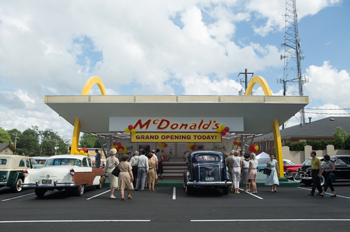 'Based on everything I had read about her, Joan said that when she and Ray first met they knew that someday they would be married," Linda Cardellini says. Although Joan and Rollie's marriage seems solid, Joan is attracted to the confidence and vision that Ray Kroc exudes. And though the two loved each other and carried on secret conversations, neither of them acted on their affection until after they were divorced and able to be married. Linda Cardellini says that one of the things that attracted Ray to Joan at this early point in his career with McDonald's was that she sees in Ray the things Ray wants seen in himself.
'Based on everything I had read about her, Joan said that when she and Ray first met they knew that someday they would be married," Linda Cardellini says. Although Joan and Rollie's marriage seems solid, Joan is attracted to the confidence and vision that Ray Kroc exudes. And though the two loved each other and carried on secret conversations, neither of them acted on their affection until after they were divorced and able to be married. Linda Cardellini says that one of the things that attracted Ray to Joan at this early point in his career with McDonald's was that she sees in Ray the things Ray wants seen in himself. 'I think she's a person who is excited by his ideas, and I think he fancies himself an idea man. And she really loves that about him. I think there's a sort of an entrepreneurial spirit they share. She's fascinated by his love of life and his excitement for the things that he does, for better and for worse." Later on, years after her marriage to Ray, Joan Kroc became one of the nation's most beloved philanthropists with her eponymous Joan B. Kroc Foundation.
Patrick Wilson is Rollie Smith, the owner of a steakhouse in Minnesota who soon becomes one of Ray Kroc's early McDonald's franchisees. Wilson, who previously worked with director John Lee Hancock on the film 'The Alamo" says, 'At the time Rollie is married to Joan and they look like a seemingly happy couple." But when Ray first meets Joan at Rollie's restaurant it sets up a longtime love story that continues through the rest of their lives. 'It's funny," Patrick Wilson reflects 'there's so much known about Joan because of what she became and her role in the McDonald's empire, but there's not a lot out there about Rollie." One of the things the actor was most impressed with in the script is that the relationship between Ray and Joan was handled with a lot of class. 'Look, I've played a lot of adulterers," he laughs, 'but Ray and Joan didn't act on it for a long time. Their relationship blossomed and evolved over time."
Patrick Wilson's was the only name the producers ever considered to play Rollie Smith. 'The reason that was important," Aaron Ryder suggests, 'was because the idea was that Joan Kroc leaves that guy for Ray. Now that's saying something! This young, vibrant, goodlooking guy is the guy that's left for this fifty-four year old milkshake machine salesman" Harry Sonneborn, the financial whiz who approached Ray Kroc in 1955 with an ingenious financial idea on how to franchise the burgeoning new chain, is played by B.J.
Novak, a successful author and regular on the NBC series 'The Office." 'Harry's a bit of a shark," says producer Aaron Ryder. 'He's well groomed, well educated, very smart and very confident. We had to find somebody that can have that sort of intensity, and when you think of all the things that B.J. has done, whether his work on -The Newsroom' or in -The Office,' he's got a lot of different tools in his box that he's able to use. So you put him in that suit and he becomes Harry pretty quickly."
Novak, whose feature film credits include 'Amazing Spider-Man 2" and Quentin Tarantino's 'Inglorious Basterds," worked with Hancock in 2013 on 'Saving Mr. Banks," in which he portrayed Robert Sherman, one-half of the legendary songwriting duo the Sherman Brothers. Sonneborn, who is at a bank when he overhears Ray Kroc failing to get a loan, catches up with him outside and seduces him into listening to an alternate business plan. 'Harry Sonneborn's idea was that McDonald's shouldn't just be a hamburger company," Novak says. 'It should be a real estate company. And what McDonald's does to this day is buy the plot of land and then lease them to the franchisees so they actually make their money as the landlord of anyone that wants the privilege of running a McDonald's. And that was a very innovative idea in the 1950s."
Novak adds that Sonneborn, who would eventually become president of McDonald's, is completely the opposite in temperament to Ray Kroc. 'Ray Kroc is a real salesman; he's great with people, but he doesn't have it all together in the numbers and the books," he says. 'And Harry Sonneborn is a real introvert who is focused on the details and the numbers. Ray is Main Street, while Harry is Wall Street."
 Newcomer Justin Randell Brooke plays Fred Turner, a sharp young man who worked the grill as a McDonald's kitchen staff member in the early years, and was promoted by Ray Kroc over the years to be his right-hand man and Vice President of Operations responsible for all the franchises. Eventually Fred Turner took over as CEO of McDonald's in the 1970s.
Newcomer Justin Randell Brooke plays Fred Turner, a sharp young man who worked the grill as a McDonald's kitchen staff member in the early years, and was promoted by Ray Kroc over the years to be his right-hand man and Vice President of Operations responsible for all the franchises. Eventually Fred Turner took over as CEO of McDonald's in the 1970s. Look For The Golden Arches! - Cinematograhy And Design
'The Founder" teams director John Lee Hancock with several frequent collaborators with whom he has worked with on films such as 'Saving Mr. Banks," 'The Blind Side," and 'The Rookie." This well-oiled machine of talent includes director of photography John Schwartzman, production designer Michael Corenblith, and costume designer Daniel Orlandi. 'We have a shorthand with each other, and it helps in prep a lot," Hancock observes. 'We kind of know what the other one's thinking already, and it makes things go more smoothly."
Cinematographer John Schwartzman marks his third collaboration with John Lee Hancock having partnered with the director on both 'The Rookie" and 'Saving Mr. Banks." Hancock sent the script to Schwartzman while the DP was filming 'Jurassic World," and the story clicked right away. In the planning stages when they were deciding on the film's overall tone, style, and pacing, Schwartzman said that he and the director immediately thought of movies from the seventies, what he considers to be the best decade in American cinema. John Schwartzman says, 'Our approach was strong compositions and a measured approach to camera movement, as well as to shoot anamorphic which allow both the actors and the audience to explore the frame rather than a moving camera leading you through it."
For the look of "The Founder," Schwartzman found inspiration in a myriad of sources, from the paintings of Edward Hopper to legendary cinematographer Gordon Willis' work from the 1971 Alan Pakula drama, "Klute," which used space and dramatic lighting to heighten the film's subtext. 'I found myself drawn to the paranoia films of Willis and Pakula," the cinematographer says. 'They were beautifully done without grandstanding."
He notes it was important that the film not look overly stylized.
Known as one of the few film purists working in the industry, with 'The Founder" the film marked the first movie the Oscar® nominated cinematographer shot in a digital format. 'John [Lee Hancock] and I are steadfast film guys, but the budget wouldn't allow for film," Schwartzman concedes, although he was pleased with the extra light sensitivity digital offered. Schwartzman opted for Arri Alexa XT cameras with Panavision anamorphic lenses with an aspect ratio of 2:39:1. To replicate a film look, John Schwartzman paid a visit to Panavision where he met with master lens technician Dan Sasaki, the company's VP of Optical Engineering, to come up with an 'imperfect set of lenses" that would 'fail in an organic way" to make the image look more in par with the film format he was accustomed to.
Michael Corenblith, the film's venerated production designer, is known for his meticulous attention to detail that drives the whole art department. The two-time Oscar® nominee is a frequent collaborator with his fellow Texas native, John Lee Hancock, having designed the sets for the director's films 'Saving Mr. Banks," 'The Blind Side," and 'The Alamo." Michael Corenblith's previous two films, 'The Finest Hours" and 'Saving Mr. Banks" were also set in the 1950s, so he had already established a veritable library of design references from the era from which to draw inspiration. Now with 'The Founder," in addition to his two prior projects as well as his work on Ron Howard's 'Apollo 13," Michael Corenblith says it deeply touches him to be able to revisit these times that were seminal experiences from his own life.
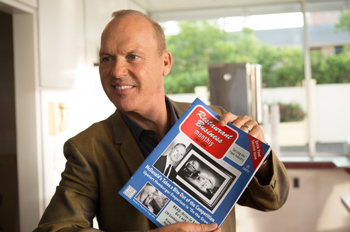 'What spoke to me thematically," Michael Corenblith recalls, 'is that we have a great distinction between pre and post World War Two America. The way that Kroc's vision for expanding McDonald's with franchising was really in harmony with what was going on in Levittown, this whole idea of what post war America was going to mean, embodied in these symbols and icons." That theme became the designer's sketchbook and template for creating the shapes and the architecture that reflected the period.
'What spoke to me thematically," Michael Corenblith recalls, 'is that we have a great distinction between pre and post World War Two America. The way that Kroc's vision for expanding McDonald's with franchising was really in harmony with what was going on in Levittown, this whole idea of what post war America was going to mean, embodied in these symbols and icons." That theme became the designer's sketchbook and template for creating the shapes and the architecture that reflected the period. Even with a vast archive of images to inform his designs, creating a vintage 1950s McDonald's required specialised research. To gain further insight, he paid frequent visits to the historic McDonald's in Downey, California, the third restaurant in the chain and the oldest one still in operation. Originally opened on August 18, 1953, the restaurant houses an on-site museum with a treasure trove of historic photography. Corenblith was looking for design details to help him create the original McDonald's octagonal-shaped walk-up hamburger stand in San Bernardino, and especially for the iconic golden arches design that soars over a red-and-white tiled exterior. The designer says, 'I had blueprints. I had manual. I had a lot of things to be working from. But I had the great fortune to be within a twenty minute drive of essentially the only true McDonald's from the period." He proceeded to take photographs, take measurements, and did colour matching so he could best replicate the design details for the 1950s golden arches McDonald's he was going to build in Atlanta.
Fashioning the look, color, and textures of the costumes that would grace Michael Corenblith's period sets is his frequent collaborator, costume designer Daniel Orlandi.
Daniel Orlandi, who has also worked on several films set in the 1950s and 1960s, including Hancock's 'Saving Mr. Banks," created the looks for Ray Kroc and the McDonald brothers, as well as women and business partners in Ray's life. Daniel Orlandi notes that while 'Saving Mr. Banks" was 'a little bit more colourful," the idea for 'The Founder" was to give it an 'uncostumed look." 'We wanted it to seem very real and organic," he notes. Taking a cue from more documentary-type archival images of regular people in the 1950s rather than from the pages of a Vogue or GQ magazine, his method was to use real period clothes on the actors that made them feel like the character. As the film progresses from the early 1950s into the early -60s, Daniel Orlandi says the clothes start to get brighter – 'more younger, fresher, more wholesome."
That changing palette was highlighted in the designs for Ethel Kroc and Joan Smith. He wanted Ethel Kroc to be very put together and concerned with her attire, while Joan should be a natural beauty that doesn't really pay that much attention. 'When Ray first meets Joan in the bar, which is a very dark, sophisticated room, there's no colour in the scene until he sees her across the room in a bright red dress," he says. 'She is like this shining beacon." Daniel Orlandi says that the character of Ray Kroc goes through a transition, too, starting from the warm, wide suits of his early 50s period, to when he meets Joan Smith and starts making money, when his suits get nicer, slimmer, and darker.
According to the costume designer, the McDonald brothers, who are more old-school and working class, dress to be comfortable. 'They're totally pleated pants, comfortable shoes, shirt and tie," Daniel Orlandi says. For the McDonald's kitchen staff and their 50's style uniforms of paper hats, white shirts and bolo ties, Daniel Orlandi wanted to be authentic to what existed. As part of his research, Daniel Orlandi even found a vintage McDonald's staff member hat on EBay and discovered the was still in business, so he got in touch with them and they agreed to make 100 circa 1950s McDonald's hats for the film.
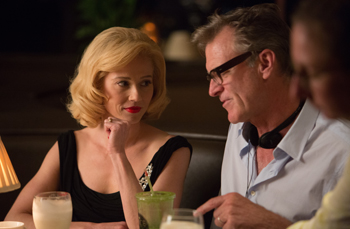 Let's Eat Out! – Locations And Filming
Let's Eat Out! – Locations And Filming'The Founder" began principal photography on June 1, 2015 in Atlanta, Georgia, where it would continue for 34 days of filming through July 17. Two additional days were filmed later in New Mexico.
With a film set primarily in Chicago, Illinois and San Bernardino, California, and at various restaurants across the Midwest, one of the biggest challenges could have been finding appropriate locations in Atlanta, Georgia that could authentically portray these mid-1950s era locales. However, in and around Atlanta, in quaint neighboring towns like Newnan, Douglasville, Canton, Griffin, Thomaston, and Avondale Estates, there was a prevalence of mid-century architecture and environments that fit the description. In a parking lot on Church Street in the downtown area of the quaint city of Douglasville, Georgia, the filmmakers built a full-scale replica of a vintage 1950s McDonald's complete with the iconic golden arches design, to portray several of the restaurants of McDonald's earliest franchisees in cities like Schaumburg, IL, Waukegan, IL, Minneapolis, MN, and Phoenix, AZ. In designing the iconic restaurant, John Lee Hancock notes that the bar was set really high for production designer Michael Corenblith in recreating a design that is so much part of people's lives and American pop culture history. 'When it comes to the golden arches, it was not only a motif in branding McDonald's, but it was kind of the holy grail for the McDonald brothers and for Ray Kroc when he first saw them," Hancock explains. 'It was somewhat of a burning bush moment for him." Many scenes of Ray Kroc at the 'golden arches" McDonald's were originally written as day scenes, but it was cinematographer John Schwartzman who convinced the director to shoot them at night. 'I knew they would look like a jewel box," Patrick Schwartzman says.
In creating the McDonald's, Michael Corenblith says he utilised USC cinema arts professor Bruce Block's concepts of Contrast and Affinity, which deals with the elements in the frame in visual storytelling. What Michael Corenblith was seeking in 'The Founder" was to differentiate the prewar Chicago look of Ray Kroc's home to the optimistic postwar American look that is exemplified by the golden arches McDonald's. He says, 'The gold, the red, and the white became the most important colours to express that. And so I was able to strategize and keep those colours out of the motion picture except for this one instance. It's like the crown jewel, or the great dessert that's been held back after the good meal."
Using movie magic, what began as two parking lots belonging to the local church and sheriff's department was transformed into a McDonald's circa 1954. Michael Corenblith had to create a structure conceived for filming, where windows and other pieces could be easily removed for the cameras and other filming equipment. The McDonald's was largely fabricated in a mill and then assembled at the Douglasville location over the course of two weeks. During filming, the site became a popular attraction for the Douglasville locals who were thrilled to find the realistic and historic McDonald's in their town.
Sadly, as soon as film was complete the structure was torn down and converted into the construction site set for Ray Kroc's first franchised location in Des Plaines, IL. At an exterior municipal parking lot in the historic city of Newnan, GA, 40 miles southwest of Atlanta, the filmmakers found an ideal location to build the McDonald brothers' original walk-up hamburger stand in San Bernardino, CA – also referred to as McDonald's No. 1. The octagonal-shaped structure, which they originally opened in 1948, pre-dated the iconic golden arches and was the first to utilize their Speedee Systems assembly line food preparation principles. Although the 1948 McDonald's is no longer in existence, the filmmakers referenced archive photos to find a surrounding that most resembled the original location. They knew they needed a building that faced north, and that also had a deep parking lot to allow for the long line of customers that Ray Kroc encounters on his initial visit. 'So the audience gets to experience sort of Kroc's wonder at seeing this the first time," production designer Michael Corenblith suggests. 'It's really told and sold by this long line of people that are moving very briskly up to get their hamburger."
Using Michael Corenblith's designs, the film's construction team built the San Bernardino McDonald's over the course of six weeks. The designer explains that since there was no colour photography of this original location, they had to make educated guesses to its colour scheme. In the way they were shaping the colour palette of the movie, the production designer says this restaurant would be the first instance of the name McDonald's and the colour gold together. 'The most important thing was seeing the McDonald brothers' name in gold, because the golden arches is such an iconic thing and had such an impact on Ray Kroc," he adds. 'It sets the stage for when Kroc sees the first golden arches in Phoenix." Collaborating with Michael Corenblith is set decorator Susan Benjamin, who also worked on Don Hancock's 'Saving Mr. Banks" and 'The Blind Side," and was responsible for taking the empty sets and furnishing them with all the period items and accessories that make them look like real McDonald's – from the stoves and the grills, to the ovens, countertops and cash registers. For the four periods the film is set in - 1954, 1957, 1961, and 1970, Benjamin infused all the sets with character, including the film's various offices, banks, restaurants, and Ray Kroc's early Illinois home and Beverly Hills mansion For research and inspiration to decorate the film's two McDonald's sets, Susan Benjamin joined other members of the film's design team on a visit to the original McDonald's in Downey, California, and its in-house museum. Although the exterior is preserved for posterity, like most restaurants the kitchen had been modernized to allow for all the new McDonald's menu items that have been added since the 1950s. 'There was never really any documented proof of the Speedee System and how it worked," Susan Benjamin says, 'so the challenge for us was to figure out how to manufacture it so it fit within the whole system and could be filmed from all sides. So this was more of a manufacturing challenge for us as well."
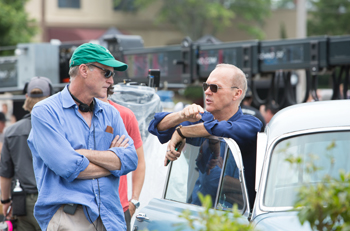 For Jason Davis, the film's prop master, his role was to provide anything that the actors hold on screen, such as watches, rings, eyewear, but in the case of 'The Founder" that also included burgers and fries. Jason Davis and his team had to recreate all the original food from McDonald's including thousands of burgers and fries used during the course of two weeks of filming at the original McDonald's sets. To achieve that they hired a popular local Atlanta food truck vendor, Loaded Burger, whose chefs were stationed on site for food preparation. During pre-production, the Loaded Burger team completed a showand- tell with the director featuring various combinations of burger patties and buns so he could choose the burgers and buns that would replicate how McDonald's burgers looked in the 1950s. 'We didn't want it to look like a modern American burger from today," Jason Davis says. 'So we toyed with different sizes until we got to a patty that didn't look too manufactured. It still looked homemade as the original McDonald brothers did it."
For Jason Davis, the film's prop master, his role was to provide anything that the actors hold on screen, such as watches, rings, eyewear, but in the case of 'The Founder" that also included burgers and fries. Jason Davis and his team had to recreate all the original food from McDonald's including thousands of burgers and fries used during the course of two weeks of filming at the original McDonald's sets. To achieve that they hired a popular local Atlanta food truck vendor, Loaded Burger, whose chefs were stationed on site for food preparation. During pre-production, the Loaded Burger team completed a showand- tell with the director featuring various combinations of burger patties and buns so he could choose the burgers and buns that would replicate how McDonald's burgers looked in the 1950s. 'We didn't want it to look like a modern American burger from today," Jason Davis says. 'So we toyed with different sizes until we got to a patty that didn't look too manufactured. It still looked homemade as the original McDonald brothers did it." Part of the benefits for the prop master was getting to sample some of his props. 'It was just like a hamburger that my grandma probably used to make!" he laughs. The props department also worked with a printing company to create thousands of cups, French fry bags, and burger wrappers. One of the most fun and challenging items for Davis to track down was the five-spindled Multi-Mixer that Ray Kroc sold for Prince Castle Sales in his early days as a traveling salesman. 'It's such a beautiful piece of machinery, and that they still work today attests to how well they were made," Jason Davis says.
The background actors who portrayed the McDonald's kitchen staff rehearsed with the film's choreographer, Kiki Ely, to create what she called a 'burger ballet." The choreographer, whose credits include 'Drumline" and 'Stomp the Yard," used a click track to help the actors stay in sync as they navigated their way through the McDonald brothers' precise food preparation process. In McDonald's company lore, prior to the installation of their Speedee Systems kitchen, the McDonald brothers drew a chalk outline of the kitchen on a tennis court and had their kitchen staff practice their maneuvers.
The Rolling Green Country Club, the private golf course and country club that Ray and Ethel Kroc belong to in Arlington Heights, IL, was filmed at East Lake Golf Club, the home course of legendary golfer Bobby Jones and the oldest golf course in the city of Atlanta. It's at Rolling Green where Ray signs his fellow members up for his latest investment opportunity: the chance to be a franchisee for the first McDonald's locations.
The golf course and tennis courts at East Lake Golf Club were also the sites of several scenes.
In Griffin, GA the historic Ed's Drive-In served as Griffith's Drive-In in St. Louis, Missouri, where we first meet traveling salesman Ray Kroc making his standard Multimixer pitch to the owner. In nearby Thomaston, GA, the circa 1950 barbecue restaurant Piggie Park doubled for both Merriman's Drive-In and Joe's Drive-In, also in St. Louis.
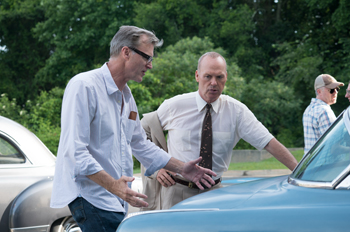 The Cherokee County Board of Education and the Canton Theater in the city of Canton portrayed, respectively, Midway Savings & Loan, and a movie theater where Ray Kroc watches the 1954 drama, 'Magnificent Obsession."
The Cherokee County Board of Education and the Canton Theater in the city of Canton portrayed, respectively, Midway Savings & Loan, and a movie theater where Ray Kroc watches the 1954 drama, 'Magnificent Obsession." Rollie's Steakhouse in Minneapolis, Minnesota, where Ray Kroc meets its owner Rollie Smith, played by Patrick Wilson, and his lovely piano-playing wife, Joan, played by Linda Cardellini, was filmed at Petite Auberge, a classic French restaurant in the Druid Hills area of Atlanta.
The San Bernardino steakhouse where the McDonald brothers tell Ray their origin story, was filmed at Alfredo's, a popular old-style Italian eatery in Atlanta's Morningside neighborhood. Its wood-paneled design evoked what a San Bernardino steakhouse would have looked like in the early 1950s.
The Yaarab Shrine Temple, a Shriners building in Atlanta, portrayed various stops during Ray Kroc's recruitment drive for new McDonald's franchisees, including a VFW Hall, Shriner's Club, and the Rockfield Lodge International Order of Odd Fellas. Ray & Ethel Kroc's modest home in the Chicago suburb of Des Plaines, Il, was filmed at a vintage 1926 home in the quaint Atlanta suburb of Avondale Estates.
Other locations included various office buildings in Downtown Atlanta that held the sets for Prince Castle Sales and Chicago & Los Angeles law firms; a Bank of America in the circa 1901 historic Beaux Arts lobby of Georgia State University's J. Mack Robinson College of Business, which doubled for Illinois First Federal bank; the old Piedmont Newnan Hospital in Newnan; and the historic Ahavath Achim Synagogue in Buckhead.
Filming was also completed on two soundstages at EUE/Screen Gems studio in Atlanta, which held the interior sets for the San Bernardino McDonald's back office, and Ray Kroc's offices at Prince Castle Sales, the Franchise Realty Corp., and the McDonald's Corporation.
After the wrap of principal photography in Atlanta on July 17, 2015, director John Lee Hancock, actor Michael Keaton, and a small crew traveled to New Mexico to shoot Ray Kroc's traveling montage that cinematographer John Schwartzman says emulates the work of the great Slavko Vorkapich, who did all the montage work in Hollywood in the -40s. 'It's why when someone travels from right to left in a car they are heading West," Patrick Schwartzman notes.
The Founder
Release Date: November 24th, 2016
Have You Seen This?
MORE
- Mission: Impossible Fallout
- Glenn Close The Wife
- Allison Chhorn Stanley's Mouth Interview
- Benicio Del Toro Sicario: Day of the Soldado
- Dame Judi Dench Tea With The Dames
- Sandra Bullock Ocean's 8
- Chris Pratt Jurassic World: Fallen Kingdom
- Claudia Sangiorgi Dalimore and Michelle Grace...
- Rachel McAdams Disobedience Interview
- Sebastián Lelio and Alessandro Nivola...
- Perri Cummings Trench Interview

